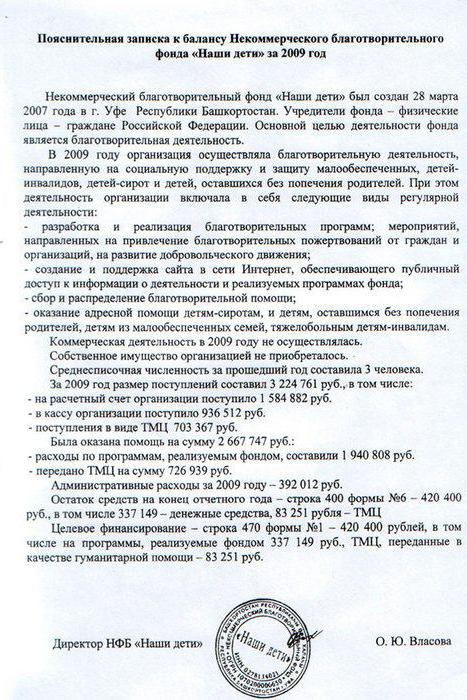The rules by which the financial statements of the organization are drawn up are approved by order of the Ministry of Finance No. 43n of July 6, 1999. In PBU 4/99, the documentation structure is defined. An explanatory note to the balance sheet acts as its integral elements. Consider this document in detail. 
General information
As mentioned above, the financial statements of an organization include several elements. These include:
- Audit report. It confirms the accuracy of the balance. The conclusion is provided by those enterprises for which, according to the norms, is provided mandatory audit.
- Final document on financial results.
- Balance sheet.
- Explanations.
- Applications
Explanatory Note to the balance sheet
This document discloses the information present in the final accounting documents. The explanatory note to the balance sheet should contain information about:
- The enterprise.
- His financial condition.
- Comparability of information for the current and previous periods.
- Assessment methods and relevant articles of the final documents.

Important point
The explanatory note to the balance sheet should also include a description of the facts of non-use of PBU in cases where their use does not allow to reliably describe the property condition and financial result of the company, with justifications. Otherwise, the relevant circumstances will be considered as evasion of the rules and act as a violation of legislative requirements. Accordingly, regulatory authorities can apply statutory sanctions against perpetrators.
Additional Information
In addition to the basic data, an accounting note may include information that accompanies the final documents if the enterprise management decides that they will be useful to users in making management decisions. Additional information includes:
- The dynamics of key financial and economic indicators of the enterprise over the past few years.
- The planned development of the company.
- Estimated capital, long-term including investments.
- Credit and loan policy, risk management.
- The activities of the enterprise in research and development.
- Environmental activities.

The explanatory note to the balance sheet may contain other additional information. These data, if necessary, can be presented in the form of diagrams, graphs or analytical tables.
Explanatory Note Example
The document is prepared according to the approved rules. An example explanatory note consists of the following sections:
- Basic information about the enterprise.
- Revenues from sales.
- Costs associated with the sale.
- The financial result obtained from the main activity.
- Other income.
- Other expenses.
- Profit tax calculation.
- The financial result of economic activity.
- Information about accounting policies.
Basic information about the enterprise
An explanatory note to the balance sheet begins with it. The form of the document is not unified. The company has the right to independently develop a form. In the section on basic information about the enterprise should be present:
- Name.
- Actual and legal address.
- Date of state registration.
- BIN.
- PPC.
- INN
- Details of the certificate, name of the issuing authority.

The basic information also indicates the number of employees, information on the size of the authorized capital, main activities.
Revenues / expenses from sales
The explanatory note to the balance sheet discloses data on revenues and expenses received / carried out during the performance of work, the provision of services, as well as the sale of goods. The document indicates specific figures for certain periods (by year). The resulting difference in accounting for management and production costs should be justified. In this case, specific calculations are provided.
Financial result from the main activity
The accounting note contains indicators for the current reporting period. In this case, the amount of profit is indicated for the purpose of taxation. In the case of non-reflection in the balance sheet of any information, this fact is explained in the note. Suppose an enterprise entered into a contract for the supply of a large consignment of goods, but the transfer and signing of the invoice was delayed. The note also indicates the account, which reflects the amount of actual costs of manufacturing products.
Other income
This section indicates the total revenue. The document also provides the value of non-operating income and the amount of funds received from the sale of fixed assets. Based on these data, the amount of income for tax purposes is indicated. The note explains the reasons for the difference. Other expenses are described in the same way. 
Profit tax calculations
The explanatory note indicates the regulatory document that guides the company when calculating the mandatory payment to the budget. They are PBU 18/02. The note should indicate the specific amount of profit for tax purposes. Sources of information are tax accounting registers and declaration information. The document describes the basic operations related to the calculation of the required payment. For example:
"The tax rate for 2013 is 20%. The amount of the calculated obligatory payment to the budget is 327,000 rubles. The amount of accounting profit is 470 thousand rubles. Contingent expense reflected in DB account 99.02.1 - 94 thousand rubles. Value deferred tax assets at the beginning of 2013 - 50 thousand rubles During the reporting period, there was an increase in IT by 34 thousand rubles. due to the formation of a temporary difference in the amount of 170 thousand p. The value of PNA (permanent tax assets) - 10 thousand rubles. It arose as a result of a difference in the amount of the constituent contribution of a participant owning a 100% share of the authorized capital. The amount of taxpayers (tax liabilities) in 2013 - 209 thousand rubles. It arose due to constant differences - 1,045,000 p. The current corporate profit tax calculated in accordance with the provisions of PBU 18/02 is 327 thousand rubles, which corresponds to the information of the declaration for 2013. " 
The financial result of economic activity
This section also indicates the specific amount received in the current year. The note describes the factors that influenced the financial result. In particular, they may be the expenses incurred and written off as a result of selling, managerial and other expenses related to the sale of a large batch of finished products released in the last quarter of the year and sold in the first quarter of the beginning of the period.
Accounting Policy Data
This section indicates the regulatory documents on the basis of which it is formed and approved. The accounting policy information describes:
- The method of repayment of the initial cost of the enterprise.
- Method for determining the useful life of acquired used OS.
- The order of reflection of assets in respect of which the conditions are observed, which serve as the basis for their acceptance as fixed assets, with a value of not more than 40 thousand rubles per 1 unit.
- The procedure for the formation of repair costs.
- The frequency of the inventory.
- The procedure for assessing the MPZ upon disposal and the formation of a reserve for the reduction of their value.
- A way to pay off the cost of special equipment.
- The method of writing off overalls, the period of operation of which is no more than 12 months.
- The procedure for creating reserves for doubtful debts for settlements with citizens and other companies.
- The recognition of revenue from the provision of services, sales of products, performance of work.

Conclusion
The final documents provided at the end of the period to interested users contain dry numbers. The necessary clarifications on certain areas of accounting gives an explanatory note to the balance sheet. The FSS in some cases requires this document, although the rules do not provide for the obligation of enterprises to provide it. The main users, as a rule, are the founders and the Federal Tax Service. The explanatory note may be checked by auditors for compliance of its indicators with the balance figures. In practice, there is usually no difficulty in compiling this document. Since there is no unified form, specialists use the well-established unwritten rules for filling out. The explanatory note must be certified by the signatures of the General Director and Chief Accountant.








